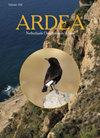Nestling Growth Pattern and Breeding Biology in the Eurasian Nuthatch Sitta europaea
IF 0.8
4区 生物学
Q3 ORNITHOLOGY
引用次数: 0
Abstract
Avian growth has been traditionally examined using logistic, Gompertz or von Bertalanffy non-linear equations. Although many studies have analysed nestling mass increase and the factors affecting growth rates, there is little information on nestling growth curves for several avian groups, such as Nuthatches (Sittidae). Moreover, the breeding biology of Nuthatches is still poorly studied because of their reluctance to use nest boxes. Here we examined the growth pattern in Eurasian Nuthatch Sitta europaea nestlings, in addition to studying the breeding biology of this species, in a mixed deciduous forest from Central Portugal during one year. The nestling growth was well fit by the logistic and Gompertz models, whilst the von Bertalanffy equation was less accurate, especially when predicting the asymptotic mass and the mass in the first development stages. Nestlings attained their maximum mass around the age of 18 days, while the largest daily mass increase was achieved when nestlings were 8 days old. Weather conditions did not affect nestling growth. Regarding the breeding biology, the mean date of laying of the first egg was 3 April, the mean clutch size was 5.43 ± 0.78 (±SD) eggs and the mean number of fledglings per clutch was 4.00 ± 2.09. The proportion of eggs that produced fledglings in a nest averaged 72%. Clutch size and number of fledglings were negatively correlated with the laying date. These results contribute to our understanding of Eurasian Nuthatch breeding biology and nestling development, the latter providing useful data for the standardization of ornithological practices, such as determining the appropriate fledgling ringing period.欧亚nuthech Sitta europaea雏鸟生长模式及繁殖生物学
传统上,鸟类的生长是用logistic、Gompertz或von Bertalanffy非线性方程来检验的。尽管许多研究已经分析了雏鸟数量的增加和影响生长率的因素,但关于几种鸟类的雏鸟生长曲线的信息很少,例如Nutchatches(Sittidae)。此外,由于Nutchecks不愿使用巢箱,因此对其繁殖生物学的研究仍然很差。在这里,我们在一年的时间里,在葡萄牙中部的一片落叶混合林中,除了研究该物种的繁殖生物学外,还研究了欧亚Nutchch Sitta europaea雏鸟的生长模式。logistic和Gompertz模型很好地拟合了雏鸟的生长,而von Bertalanffy方程则不太准确,尤其是在预测渐近质量和第一发育阶段的质量时。雏鸟在18日龄左右达到最大质量,而雏鸟在8日龄时达到最大日质量增长。天气条件不影响雏鸟的生长。关于繁殖生物学,第一个蛋的平均产卵日期为4月3日,平均窝大小为5.43±0.78(±SD)个蛋,每个窝的平均雏鸟数量为4.00±2.09。孵化出雏鸟的蛋的比例平均为72%。离合器大小和雏鸟数量与产卵日期呈负相关。这些结果有助于我们理解欧亚Nutchch繁殖生物学和雏鸟发育,后者为鸟类学实践的标准化提供了有用的数据,例如确定合适的雏鸟振铃期。
本文章由计算机程序翻译,如有差异,请以英文原文为准。
求助全文
约1分钟内获得全文
求助全文
来源期刊

Ardea
生物-鸟类学
CiteScore
2.10
自引率
0.00%
发文量
49
审稿时长
>12 weeks
期刊介绍:
Ardea is the scientific journal of the Netherlands Ornithologists'' Union, and is published since 1912. The journal welcomes manuscripts reporting significant new findings in ornithology, in particular those covering the ecology, life history, and evolution of birds, and including sound descriptive work. Ardea publishes Original research papers, Short notes and Book reviews. In addition to the regular three issues per year, Ardea publishes specials that contain conference or workshop proceedings (produced on request).
 求助内容:
求助内容: 应助结果提醒方式:
应助结果提醒方式:


